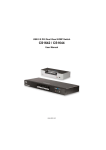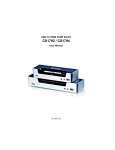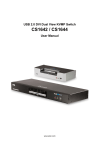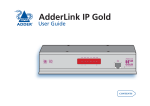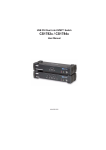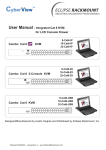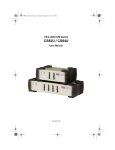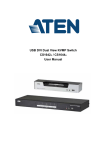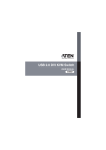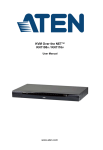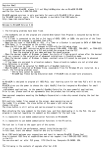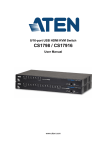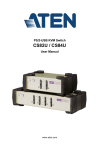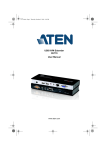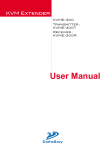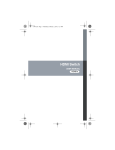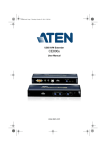Download Manual - produktinfo.conrad.com
Transcript
2x4 DVI-HD Audio/Video Matrix KVMP Switch CM0264 User Manual www.aten.com CM0264 User Manual FCC Information This equipment has been tested and found to comply with the limits for a Class B digital device, pursuant to Part 15 of the FCC Rules. These limits are designed to provide reasonable protection against harmful interference in a residential installation. This equipment generates, uses and can radiate radio frequency energy, and if not installed and used in accordance with the instruction manual, may cause interference to radio communications. However, there is no guarantee that interference will not occur in a particular installation. If this equipment does cause harmful interference to radio or television reception, which can be determined by turning the equipment off and on, the user is encouraged to try to correct the interference by one or more of the following measures: Reorient or relocate the receiving antenna; Increase the separation between the equipment and receiver; Connect the equipment into an outlet on a circuit different from that which the receiver is connected; Consult the dealer/an experienced radio/television technician for help. RoHS This product is RoHS compliant. SJ/T 11364-2006 The following contains information that relates to China. ii CM0264 User Manual User Information Online Registration Be sure to register your product at our online support center: International http://support.aten.com North America http://www.aten-usa.com/product_registration Telephone Support For telephone support, call this number: International 886-2-8692-6959 China 86-10-5255-0110 Japan 81-3-5615-5811 Korea 82-2-467-6789 North America 1-888-999-ATEN ext 4988 United Kingdom 44-8-4481-58923 User Notice All information, documentation, and specifications contained in this manual are subject to change without prior notification by the manufacturer. The manufacturer makes no representations or warranties, either expressed or implied, with respect to the contents hereof and specifically disclaims any warranties as to merchantability or fitness for any particular purpose. Any of the manufacturer's software described in this manual is sold or licensed as is. Should the programs prove defective following their purchase, the buyer (and not the manufacturer, its distributor, or its dealer), assumes the entire cost of all necessary servicing, repair and any incidental or consequential damages resulting from any defect in the software. The manufacturer of this system is not responsible for any radio and/or TV interference caused by unauthorized modifications to this device. It is the responsibility of the user to correct such interference. The manufacturer is not responsible for any damage incurred in the operation of this system if the correct operational voltage setting was not selected prior to operation. PLEASE VERIFY THAT THE VOLTAGE SETTING IS CORRECT BEFORE USE. The CM0264 provides free Open Source software. For further details, please go to http://www.aten.com/opensource iii CM0264 User Manual Package Contents The CM0264 package consists of: 1 CM0264 2x4 DVI-HD Audio/Video Matrix KVMP Switch 2 Custom HD audio/video KVM Cable Sets 2 Custom DVI-D KVM Cable Sets 1 Power Adapter 1 USB-to-PS/2 Converter 1 Foot Pad Set (4 pcs) 1 User Instructions* Check to make sure that all the components are present and that nothing got damaged in shipping. If you encounter a problem, contact your dealer. Read this manual thoroughly and follow the installation and operation procedures carefully to prevent any damage to the unit, and/or any of the devices connected to it. * Features may have been added to the CM0264 since this manual was printed. Please visit our website to download the most up-to-date version. © Copyright 2010–2012 ATEN® International Co., Ltd. Manual Part No. PAPE-0323-AT3G F/W Version: v1.0.097 Manual Date: 2012-04-11 ATEN and the ATEN logo are registered trademarks of ATEN International Co., Ltd. All rights reserved. All other brand names and trademarks are the registered property of their respective owners. iv CM0264 User Manual Contents FCC Information . . . . . . . . . . . . . . . . . . . . . . . . . . . . . . . . . . . . . . . . . . . . . ii User Information . . . . . . . . . . . . . . . . . . . . . . . . . . . . . . . . . . . . . . . . . . . . .iii Online Registration . . . . . . . . . . . . . . . . . . . . . . . . . . . . . . . . . . . . . . . .iii Telephone Support . . . . . . . . . . . . . . . . . . . . . . . . . . . . . . . . . . . . . . . .iii User Notice . . . . . . . . . . . . . . . . . . . . . . . . . . . . . . . . . . . . . . . . . . . . . .iii Package Contents. . . . . . . . . . . . . . . . . . . . . . . . . . . . . . . . . . . . . . . . . . . iv About this Manual . . . . . . . . . . . . . . . . . . . . . . . . . . . . . . . . . . . . . . . . . . .viii Conventions . . . . . . . . . . . . . . . . . . . . . . . . . . . . . . . . . . . . . . . . . . . . . . . ix Product Information. . . . . . . . . . . . . . . . . . . . . . . . . . . . . . . . . . . . . . . . . . ix 1. Introduction Overview . . . . . . . . . . . . . . . . . . . . . . . . . . . . . . . . . . . . . . . . . . . . . . . . . . . 1 Features . . . . . . . . . . . . . . . . . . . . . . . . . . . . . . . . . . . . . . . . . . . . . . . . . . . 2 Requirements . . . . . . . . . . . . . . . . . . . . . . . . . . . . . . . . . . . . . . . . . . . . . . . 3 Console . . . . . . . . . . . . . . . . . . . . . . . . . . . . . . . . . . . . . . . . . . . . . . . . . 3 Computers . . . . . . . . . . . . . . . . . . . . . . . . . . . . . . . . . . . . . . . . . . . . . . . 3 Hardware . . . . . . . . . . . . . . . . . . . . . . . . . . . . . . . . . . . . . . . . . . . . . . . . 3 Cables . . . . . . . . . . . . . . . . . . . . . . . . . . . . . . . . . . . . . . . . . . . . . . . . . . 3 Operating Systems . . . . . . . . . . . . . . . . . . . . . . . . . . . . . . . . . . . . . . . . 4 CM0264 . . . . . . . . . . . . . . . . . . . . . . . . . . . . . . . . . . . . . . . . . . . . . . 4 CM0264 Graphical User Interface (GUI) . . . . . . . . . . . . . . . . . . . . . 4 Graphical User Interface (GUI) Language. . . . . . . . . . . . . . . . . . . . . . . 4 Components . . . . . . . . . . . . . . . . . . . . . . . . . . . . . . . . . . . . . . . . . . . . . . . . 5 Front View . . . . . . . . . . . . . . . . . . . . . . . . . . . . . . . . . . . . . . . . . . . . . . . 5 LED Status Panel Detail . . . . . . . . . . . . . . . . . . . . . . . . . . . . . . . . . 5 Rear View . . . . . . . . . . . . . . . . . . . . . . . . . . . . . . . . . . . . . . . . . . . . . . . 7 2. Hardware Setup Cable Connection . . . . . . . . . . . . . . . . . . . . . . . . . . . . . . . . . . . . . . . . . . . . 9 Installation Diagram. . . . . . . . . . . . . . . . . . . . . . . . . . . . . . . . . . . . . . . 11 3. Basic Operation Overview . . . . . . . . . . . . . . . . . . . . . . . . . . . . . . . . . . . . . . . . . . . . . . . . . . 13 Default Display and Power On Sequence . . . . . . . . . . . . . . . . . . . . . . 13 Non-PC Devices . . . . . . . . . . . . . . . . . . . . . . . . . . . . . . . . . . . . . . . . . 13 LED Display . . . . . . . . . . . . . . . . . . . . . . . . . . . . . . . . . . . . . . . . . . . . . . . 14 Manual Switching . . . . . . . . . . . . . . . . . . . . . . . . . . . . . . . . . . . . . . . . . . . 15 Single Display Console . . . . . . . . . . . . . . . . . . . . . . . . . . . . . . . . . . . . 15 Dual Display Console . . . . . . . . . . . . . . . . . . . . . . . . . . . . . . . . . . . . . 17 Switching the Non-KVM Video . . . . . . . . . . . . . . . . . . . . . . . . . . . . . . . . . 18 Hot Plugging . . . . . . . . . . . . . . . . . . . . . . . . . . . . . . . . . . . . . . . . . . . . . . . 19 Powering Off and Restarting . . . . . . . . . . . . . . . . . . . . . . . . . . . . . . . . . . . 19 KVM Reset . . . . . . . . . . . . . . . . . . . . . . . . . . . . . . . . . . . . . . . . . . . . . . . . 19 Port ID Numbering . . . . . . . . . . . . . . . . . . . . . . . . . . . . . . . . . . . . . . . . . . 19 v CM0264 User Manual 4. Keyboard Port Operation Port Switching. . . . . . . . . . . . . . . . . . . . . . . . . . . . . . . . . . . . . . . . . . . . . . 21 Single Display Console . . . . . . . . . . . . . . . . . . . . . . . . . . . . . . . . . . . . 21 Cycling Through the Ports . . . . . . . . . . . . . . . . . . . . . . . . . . . . . . . 21 Going Directly to a Port . . . . . . . . . . . . . . . . . . . . . . . . . . . . . . . . . 22 Dual Display Console . . . . . . . . . . . . . . . . . . . . . . . . . . . . . . . . . . . . . 23 Cycling Through the Ports . . . . . . . . . . . . . . . . . . . . . . . . . . . . . . . 23 Going Directly to a Port . . . . . . . . . . . . . . . . . . . . . . . . . . . . . . . . . 24 Auto Scanning. . . . . . . . . . . . . . . . . . . . . . . . . . . . . . . . . . . . . . . . . . . 26 Hotkey Setting Mode . . . . . . . . . . . . . . . . . . . . . . . . . . . . . . . . . . . . . . . . 27 Invoking HSM . . . . . . . . . . . . . . . . . . . . . . . . . . . . . . . . . . . . . . . . . . . 27 Alternate HSM Invocation Keys . . . . . . . . . . . . . . . . . . . . . . . . . . . . . 27 Alternate Port Switching Keys. . . . . . . . . . . . . . . . . . . . . . . . . . . . . . . 28 Keyboard Operating Platform . . . . . . . . . . . . . . . . . . . . . . . . . . . . . . . 28 List Switch Settings . . . . . . . . . . . . . . . . . . . . . . . . . . . . . . . . . . . . . . . 29 USB Reset . . . . . . . . . . . . . . . . . . . . . . . . . . . . . . . . . . . . . . . . . . . . . 29 Keyboard Language . . . . . . . . . . . . . . . . . . . . . . . . . . . . . . . . . . . . . . 29 Hotkey Buzzer Control . . . . . . . . . . . . . . . . . . . . . . . . . . . . . . . . . . . . 29 Disable Port Switching Keys . . . . . . . . . . . . . . . . . . . . . . . . . . . . . . . . 30 Firmware Upgrade Mode . . . . . . . . . . . . . . . . . . . . . . . . . . . . . . . . . . 30 Restore Default Settings . . . . . . . . . . . . . . . . . . . . . . . . . . . . . . . . . . . 30 Video DynaSync . . . . . . . . . . . . . . . . . . . . . . . . . . . . . . . . . . . . . . . . . 30 Keyboard Emulation Control . . . . . . . . . . . . . . . . . . . . . . . . . . . . . . . . 31 Mouse Emulation Control . . . . . . . . . . . . . . . . . . . . . . . . . . . . . . . . . . 31 Cursor Shift Port Switching . . . . . . . . . . . . . . . . . . . . . . . . . . . . . . . . . 31 SPC Mode . . . . . . . . . . . . . . . . . . . . . . . . . . . . . . . . . . . . . . . . . . . . . 31 HSM Summary Table . . . . . . . . . . . . . . . . . . . . . . . . . . . . . . . . . . . . . . . . 32 Factory Default Hotkey Settings . . . . . . . . . . . . . . . . . . . . . . . . . . . . . 32 5. GUI Operation Overview. . . . . . . . . . . . . . . . . . . . . . . . . . . . . . . . . . . . . . . . . . . . . . . . . . 33 Activating the GUI. . . . . . . . . . . . . . . . . . . . . . . . . . . . . . . . . . . . . . . . . . . 33 The Toolbar . . . . . . . . . . . . . . . . . . . . . . . . . . . . . . . . . . . . . . . . . . . . . . . 35 The File Management Utility . . . . . . . . . . . . . . . . . . . . . . . . . . . . . . . . . . . 36 File Transfer GUI. . . . . . . . . . . . . . . . . . . . . . . . . . . . . . . . . . . . . . . . . 36 File Transfer Buttons . . . . . . . . . . . . . . . . . . . . . . . . . . . . . . . . . . . 38 Target Computer Section . . . . . . . . . . . . . . . . . . . . . . . . . . . . . . . 38 Transferring Files . . . . . . . . . . . . . . . . . . . . . . . . . . . . . . . . . . . . . . . . 39 Drag and Drop . . . . . . . . . . . . . . . . . . . . . . . . . . . . . . . . . . . . . . . . 39 Send and Receive . . . . . . . . . . . . . . . . . . . . . . . . . . . . . . . . . . . . . 39 Copy and Paste. . . . . . . . . . . . . . . . . . . . . . . . . . . . . . . . . . . . . . . 39 Other File Management Features . . . . . . . . . . . . . . . . . . . . . . . . . . . . 39 3n1 View Desktop Control and Monitoring . . . . . . . . . . . . . . . . . . . . . . . . 40 Matrix Windows. . . . . . . . . . . . . . . . . . . . . . . . . . . . . . . . . . . . . . . . . . 40 Non-PC Devices . . . . . . . . . . . . . . . . . . . . . . . . . . . . . . . . . . . . . . 40 Matrix Windows Display Sequence. . . . . . . . . . . . . . . . . . . . . . . . . . . 41 vi CM0264 User Manual Basic Functions. . . . . . . . . . . . . . . . . . . . . . . . . . . . . . . . . . . . . . . . . . . . . 42 Navigation . . . . . . . . . . . . . . . . . . . . . . . . . . . . . . . . . . . . . . . . . . . . . . 42 Advanced Functions . . . . . . . . . . . . . . . . . . . . . . . . . . . . . . . . . . . . . . . . . 43 Port Switching via Matrix Windows . . . . . . . . . . . . . . . . . . . . . . . . . . . 43 Cursor Shift . . . . . . . . . . . . . . . . . . . . . . . . . . . . . . . . . . . . . . . . . . . . . 44 RTF Transfer Using CnP . . . . . . . . . . . . . . . . . . . . . . . . . . . . . . . . . . . 44 Desktop Scaling . . . . . . . . . . . . . . . . . . . . . . . . . . . . . . . . . . . . . . . . . . . . 45 Before . . . . . . . . . . . . . . . . . . . . . . . . . . . . . . . . . . . . . . . . . . . . . . . . . 45 After . . . . . . . . . . . . . . . . . . . . . . . . . . . . . . . . . . . . . . . . . . . . . . . . . . . 45 6. The Firmware Upgrade Utility Before you Begin. . . . . . . . . . . . . . . . . . . . . . . . . . . . . . . . . . . . . . . . . . . . 47 Starting the Upgrade . . . . . . . . . . . . . . . . . . . . . . . . . . . . . . . . . . . . . . . . . 48 Upgrade Succeeded . . . . . . . . . . . . . . . . . . . . . . . . . . . . . . . . . . . . . . . . . 51 Upgrade Failed . . . . . . . . . . . . . . . . . . . . . . . . . . . . . . . . . . . . . . . . . . . . . 51 Appendix Safety Instructions. . . . . . . . . . . . . . . . . . . . . . . . . . . . . . . . . . . . . . . . . . . 53 Technical Support . . . . . . . . . . . . . . . . . . . . . . . . . . . . . . . . . . . . . . . . . . . 55 International. . . . . . . . . . . . . . . . . . . . . . . . . . . . . . . . . . . . . . . . . . . . . 55 North America . . . . . . . . . . . . . . . . . . . . . . . . . . . . . . . . . . . . . . . . . . . 55 Specifications . . . . . . . . . . . . . . . . . . . . . . . . . . . . . . . . . . . . . . . . . . . . . . 56 Troubleshooting . . . . . . . . . . . . . . . . . . . . . . . . . . . . . . . . . . . . . . . . . . . . 57 KVM Reset / Reinstallation . . . . . . . . . . . . . . . . . . . . . . . . . . . . . . . . . . . . 59 Mac Keyboard Emulation . . . . . . . . . . . . . . . . . . . . . . . . . . . . . . . . . . . . . 61 Factory Default Hotkeys and Settings. . . . . . . . . . . . . . . . . . . . . . . . . . . . 62 Limited Warranty . . . . . . . . . . . . . . . . . . . . . . . . . . . . . . . . . . . . . . . . . . . . 62 vii CM0264 User Manual About this Manual This User Manual is provided to help you get the most from your system. It covers all aspects of installation, configuration and operation. An overview of the information found in the manual is provided below. Chapter 1, Introduction, introduces you to the CM0264 system. Its purpose, features and benefits are presented, and its front and back panel components are described. Chapter 2, Hardware Setup, describes how to set up your installation. Diagrams showing the necessary steps are provided. Chapter 3, Basic Operation, explains the fundamental concepts involved in operating the CM0264. Chapter 4, Keyboard Port Operation, details all of the concepts and procedures involved in the Hotkey operation of your CM0264 installation. Chapter 5, GUI Operation, provides a complete description of the CM0264’s Graphical User Interface (GUI), and how to work with it. Chapter 6, The Firmware Upgrade Utility, explains how to upgrade the CM0264's firmware with the latest available versions. An Appendix, provides specifications and other technical information regarding the CM0264. viii CM0264 User Manual Conventions This manual uses the following conventions: Monospaced Indicates text that you should key in. [] Indicates keys you should press. For example, [Enter] means to press the Enter key. If keys need to be chorded, they appear together in the same bracket with a plus sign between them: [Ctrl+Alt]. 1. Numbered lists represent procedures with sequential steps. ♦ Bullet lists provide information, but do not involve sequential steps. → Indicates selecting the option (on a menu or dialog box, for example), that comes next. For example, Start → Run means to open the Start menu, and then select Run. Indicates critical information. Product Information For information about all ATEN products and how they can help you connect without limits, visit ATEN on the Web or contact an ATEN Authorized Reseller. Visit ATEN on the Web for a list of locations and telephone numbers: International http://www.aten.com North America http://www.aten-usa.com ix CM0264 User Manual This Page Intentionally Left Blank x Chapter 1 Introduction Overview The CM0264 2x4 DVI-HD Audio/Video Matrix KVMP Switch charts a revolutionary new direction in KVM switch functionality by combining a 2port HD audio/video KVM switch and a 2-port DVI KVM switch with a 2-port USB 2.0 hub in a dual display console setup with a Graphical User Interface (GUI) and a range of innovative desktop control features. The CM0264 2x4 DVI-HD Audio/Video Matrix KVMP Switch’s Dual Display Console supports one DVI display and one HD audio/video display, allowing users to access 4 computers/devices from a single console, consisting of USB keyboard, USB mouse, and one or two displays. As USB hub, it permits each computer to access connected peripherals on a one-computer-ata-time basis. As a matrix switch, the CM0264 enables effortless switching between two DVI sources and two HD audio/video sources via hotkeys, pushbuttons, mouse, and GUI. In addition, with support for two console displays, the CM0264 offers 3n1 picture-in-picture view mode that allows you to monitor up to four computers simultaneously. Further innovative desktop control features include on-screen file transfer and copy-paste functionality, as well as Cursor Shift port switching in dual-display mode. Recognizing the increased importance of digital audio, the CM0264’s two HD audio/video interfaces integrate multi-channel audio support that allows users to experience high-definition audio such as Dolby True HD and DTS HD Master Audio. Furthermore, a single microphone can provide audio input to each of the computers, and you can listen to the audio output of each computer on a single set of speakers (on a one-at-a-time basis). As with the USB peripherals, the audio focus can be independent of the KVM focus. With its unique design and innovative features, the CubiQ CM0264 2x4 DVIHD Audio/Video Matrix KVMP Switch provides both style and functionality for the SOHO environment. Allowing you to switch seamlessly between two HD audio/video- and two DVI-enabled PCs, and share USB peripherals and high-definition audio from a dual-display console, the CM0264 is ideal for multimedia applications, and offers the ultimate in space-saving, streamlined KVM technology for the desktop. 1 CM0264 User Manual Features 4-port 2x4 DVI-HD Audio/Video Matrix KVMP Switch One Dual Display USB console independently and simultaneously controls two DVI computers, two HD audio/video computers or devices, and two additional USB devices Dual Display Console supports two displays – one DVI display and one HD audio/video display Graphical User Interface (GUI) for convenient, user-friendly operation File system management utility – transfer files between PCs 2-port USB 2.0 hub built in; fully compliant with USB 2.0 specification Independent switching of KVM, USB peripheral, and audio focus Computer selection via front panel pushbuttons, hotkeys, mouse, and GUI Dolby True HD and DTS HD Master Audio support Superior video quality – up to 1920 x 1200 (DVI Single Link), 1080p (HD audio/video) Supports widescreen resolutions Multiplatform support – Windows 2000/XP/Vista/7, Linux, and Mac Console mouse port emulation/bypass feature supports most mouse drivers and multifunction mice Cursor Shift Function – in dual-display mode, the mouse cursor can move back and forth across both displays, shifting the KVM focus Video DynaSyncTM – Exclusive ATEN technology eliminates boot-up display problems and optimizes resolution when switching between ports Power on detection – if one of the computers is powered off, the CM0264 automatically switches to the next powered-on computer Console keyboard port emulation/bypass feature supports most gaming/ multimedia keyboards Complete keyboard emulation for error-free booting Mac keyboard support and emulation* Auto Scan Mode for monitoring all computers and HD audio/video devices Firmware Upgradable * 1. PC keyboard combinations emulate Mac keyboards. 2. Mac keyboards only work with their own computers 2 Chapter 1. Introduction Requirements Console A HD audio/video display capable of the highest possible resolution A DVI Single Link display capable of the highest possible resolution A USB mouse A USB keyboard Note: A PS/2 keyboard and mouse can be used with the converter included in the CM0264 package. Microphone and speakers (optional) Computers The following must be available on each computer: A HD audio/video port or DVI port Note: The quality of the display is affected by the quality of the display card. We recommend you purchase a high quality product. USB Type A port Audio ports (optional) Hardware 2.0Ghz processor 1GB RAM Cables Two custom DVI-D Single Link KVM cable sets and two custom HD audio/ video KVM cable sets are provided with this package. Converters The following optional converters are available for the CM0264: Converter Part Number HD audio/video (F) to DVI (M) Converter 2A-127G HD audio/video (M) to DVI (F) Converter 2A-128G 3 CM0264 User Manual Operating Systems Supported operating systems are shown in the tables, below: CM0264 OS Version Windows Linux 2000 and higher RedHat 6.0 and higher SuSE 8.2 and higher UNIX FreeBSD 3.51 and higher Novell Netware 6.0 and higher Mac OS 9 and higher CM0264 Graphical User Interface (GUI) OS Windows Version XP, 2003, 2008, Vista x86/x64, Windows 7 x86/x64 Graphical User Interface (GUI) Language The CM0264’s GUI is in English. 4 Chapter 1. Introduction Components Front View 1 2 3 2 4 5 LED Status Panel Detail 2 3 2 5 CM0264 User Manual No. Component Description 1 LED Status Panel This panel contains LED icons that light to indicate mode and port status. The Mode and Port Selection Pushbuttons each have three corresponding LED icons that represent audio, KVM1/V2, and USB status. See LED Display, page 14, for full details. 2 Port Selection Pushbuttons Press the Port Selection Pushbuttons to manually switch ports. See Manual Switching, page 15, for full details. Press and hold Port Selection Pushbuttons 1 and 2 simultaneously for 2 seconds to start Auto Scan Mode. See Going Directly to a Port, page 24, for full details. Press and hold Port Selection Pushbuttons 3 and 4 simultaneously for 2 seconds to execute a KVM reset. See KVM Reset, page 19 for full details. 3 Mode Selection Pushbutton This pushbutton allows you to cycle through the three modes of focus – KVM1/V2, audio, and USB. Press and hold Mode Selection Pushbutton before powering on the CM0264 to enter Firmware Upgrade Mode. See Starting the Upgrade, page 49 for full details. 6 4 Console Audio Ports Your speakers and microphone plug in here. 5 USB 2.0 Peripheral Port USB 2.0 peripherals (printers, scanners, etc.) plug into this port. Chapter 1. Introduction Rear View 1 2 3 4 5 No. 3 Component 4 Description 1 USB 2.0 Peripheral Port USB 2.0 peripherals (printers, scanners, etc.) can plug into this port. 2 Console Port Section The cables from your USB keyboard, USB mouse, DVI console display, HD audio/video console display, microphone and speakers plug into this section. 3 HD audio/video KVM Port Section The cables that link the CM0264 to your HD audio/ video computers / devices plug in here. Each HD audio/video KVM port is comprised of a microphone jack, speaker jack, USB type B socket, and an HD audio/video connector. 4 DVI KVM Port Section The cables that link the CM0264 to your DVI Single Link computers plug in here. Each DVI KVM port is comprised of a microphone jack, speaker jack, USB type B socket, and a DVI-I Single Link connector. 5 Power Jack The power adapter cable plugs into this jack. 7 CM0264 User Manual This Page Intentionally Left Blank 8 Chapter 2 Hardware Setup 1. Important safety information regarding the placement of this device is provided on page 55. Please review it before proceeding. 2. Make sure that the power to all devices connected to the installation is turned off. You must unplug the power cords of any computers that have the Keyboard Power On function. Cable Connection To set up your CM0264 installation, refer to the installation diagram on page 11 (the numbers in the diagrams correspond to the steps, below), and do the following: 1. Plug your USB keyboard and USB mouse into the USB Console Ports located on the unit’s rear panel. 2. Plug your DVI display into the Console DVI-I Single Link Port located on the unit’s rear panel. 3. Plug your HD audio/video display into the Console HD audio/video Port located on the unit’s rear panel. 4. If you are using an IP phone headset or separate microphone and speakers, plug them into the analog audio ports on the unit’s front panel. These audio ports have priority over those on the rear panel. 5. If you are using separate speakers and microphone, plug them into the console analog audio ports on the unit’s rear panel. 6. Using the custom DVI KVM cable set, plug the DVI-D Single Link cable connector and the accompanying USB and audio connectors their corresponding sockets on the rear of the switch. 7. At the other end of the cable, plug the DVI and USB cables into their respective ports on the computer(s) that is(are) the source of DVI content. (Continues on next page.) 9 CM0264 User Manual (Continued from previous page.) 8. Using the custom HD audio/video KVM cable set, plug the HD audio/ video cable connectors and accompanying USB and audio connectors (if required) into their corresponding sockets on the rear of the switch. Note: If the HD audio/video console display has built-in speakers and supports audio through its HD audio/video interface, there is no need to use the speaker connectors on the custom HD audio/video KVM cable sets. 9. At the other end of the cable, plug the HD audio/video and USB cables into their respective ports on the computer(s)/device(s) that is (are) the source of HD audio/video content. Note: If the source of HD audio/video content is non-PC, such as a DVD player, a male-to-male HD audio/video cable can be used instead of the custom HD audio/video KVM cable set. 10. Plug your USB peripherals into the type A sockets (one easy-access port is located on the front for portable devices; the second is located on the rear). 11. Power on the displays. 12. Plug the power adapter that came with the CM0264 package into an AC power source, then plug the power adapter cable into the switch’s power jack. 13. Power on the computers/devices. Note: The recommended power-on sequence is Port 1–Port 2–Port 3–Port 4. See Default Display and Power On Sequence, page 13, for further details 10 Chapter 2. Hardware Setup Installation Diagram 4 10 5 1 10 2 3 12 8 I HDM 7 6 DVI 9 11 CM0264 User Manual This Page Intentionally Left Blank 12 Chapter 3 Basic Operation Overview There are four convenient methods to access the computers: manual, hotkey, Cursor Shift, and Matrix Windows in the Graphical User Interface (GUI). Manual operation involves pressing the Mode and port selection pushbuttons located on the unit’s front panel. This is discussed in this chapter. Hotkey operation, which involves entering combinations from the keyboard, is discussed in Chapter 4. Port switching via Cursor Shift and Matrix Windows in the GUI are discussed in Chapter 5. Default Display and Power On Sequence The CM0264’s default display is the DVI display. The first powered-on computer or device displays on the DVI display and has the default KVM focus. This means that, if an HD audio/video computer/device attached to Port 2, for example, is powered on first, it has the default KVM focus but displays on the DVI display*. Therefore, we recommend that your computers/devices are powered on in sequence, starting with the computer/device attached to Port 1 and ending with the computer/device attached to Port 4. * An HD audio/video computer/device displays video on a DVI display, but HD audio/video audio is not supported. Non-PC Devices Non-PC devices, such as DVD players, can only be accessed using the CM0264’s front panel pushbuttons (see Manual Switching, page 15) or keyboard hotkeys (see Port Switching, page 21). Furthermore, as non-PC devices cannot have complete KVM focus (only video), see Switching the NonKVM Video, page 18 for further details. 13 CM0264 User Manual LED Display The Mode and Port Selection Pushbuttons on the CM0264’s front panel each have three corresponding LED icons that represent audio, KVM1/V2, and USB. These light green or orange, depending on status, as shown in the table, below: Note: To ensure the LEDs display correctly, please follow the recommended power-on sequence. See Default Display and Power On Sequence, page 13, for details. LED Mode Port Indication KVM Lights BRIGHT ORANGE to indicate KVM1 is selected Lights BRIGHT GREEN to indicate V2 is selected Audio Lights BRIGHT GREEN to indicate Audio is selected USB Lights BRIGHT GREEN to indicate USB is selected KVM OFF to indicate port is not selected. Lights BRIGHT ORANGE to indicate that the computer attached its corresponding port has the KVM1 focus (and is showing on the DVI display). Lights BRIGHT GREEN to indicate that the computer attached to its corresponding port has the V2 focus (and is showing on the HD audio/video display). Flashes to indicate that the computer attached to its corresponding port is being accessed in Auto Scan Mode. All flash ORANGE to indicate that Firmware Upgrade mode has been invoked. Audio Lights BRIGHT GREEN to indicate that the computer attached to its corresponding port has the Audio focus. USB Lights BRIGHT GREEN to indicate that the computer attached to its corresponding port has the USB focus. Note: 1. The Port Selection KVM icon is the port number (1, 2, 3, and 4). 2. KVM1 refers to KVM focus via the current console display; V2 refers to video only focus via the other console display. 14 Chapter 3. Basic Operation Manual Switching The Mode selection pushbutton and the pushbuttons that correspond to each port have three icons – KVM, audio, and USB. The icons on the Mode pushbutton light up when the Mode pushbutton is pressed to indicate cycling through the corresponding KVM, audio, and USB modes. The icons on the port selection pushbuttons light up to indicate the current status of the computer that corresponds to that port. For example, if the audio icon is lit up above the port 3 selection pushbutton, this indicates that the computer attached to port 3 currently has the audio focus. The CM0264 can be operated using one DVI Single Link console display or one DVI Single Link display and one HD audio/video console display. Manual switching differs slightly for each setup. For example, when using a single display console, there is a single KVM focus; when using a dual display console, there is one KVM focus (KVM1) and one further video focus (V2). See the following sections for details. Single Display Console To bring complete focus (audio, KVM, and USB) to a computer, either, a) press the port selection pushbutton that corresponds to that computer; or b) press the Mode pushbutton once (the Mode pushbutton’s three icons light up) and then press the port selection pushbutton that corresponds to that computer. All three port icons light up. To bring only the KVM focus to a computer, press the Mode pushbutton twice (the Mode pushbutton’s KVM icon lights up), and then press the port selection pushbutton that corresponds to that computer. The port’s KVM icon (the port number) lights up. To bring only the audio focus to a computer, press the Mode pushbutton three times (the Mode pushbutton’s audio icon lights up), and then press the port selection pushbutton that corresponds to that computer. The port’s audio icon lights up. To bring only the USB focus to a computer, press the Mode pushbutton four times (the Mode pushbutton’s USB icon lights up), and then press the port selection pushbutton that corresponds to that computer. The port’s USB icon lights up. (Continues on next page.) 15 CM0264 User Manual (Continued from previous page.) Press and hold port selection pushbuttons 1 and 2 simultaneously for 2 seconds to start Auto Scan Mode. See Going Directly to a Port, page 24 for details. Note: Press and release either port selection pushbutton to stop Auto Scan Mode. The KVM focus goes to the computer attached to the corresponding port of the pushbutton you pressed. Press and hold port selection pushbuttons 3 and 4 simultaneously for 2 seconds to execute a KVM reset. See KVM Reset, page 19 for details. 16 Chapter 3. Basic Operation Dual Display Console In Dual Display Console mode, the CM0264 supports both a DVI and an HD audio/video display, and it is possible for either monitor to have the current KVM focus, while the other has video focus only. In following section, KVM1 refers to KVM focus via the current console display; V2 refers to video only focus on the other monitor. Note: The KVM1 LED lights orange; the V2 LED lights green. To bring complete focus (audio, KVM1 and USB) to a computer, either, a) press the port selection pushbutton that corresponds to that computer; or b) press the Mode pushbutton once (the Mode pushbutton’s three icons light up) and then press the port selection pushbutton that corresponds to that computer. All three port icons light up. To bring only the KVM1 focus to a computer, press the Mode pushbutton twice (the Mode pushbutton’s KVM icon lights up), and then press the port selection pushbutton that corresponds to that computer. The port’s KVM icon (the port number) lights up. To bring only the V2 focus to a computer, press the Mode pushbutton three times (the Mode pushbutton’s KVM icon lights up), and then press the port selection pushbutton that corresponds to that computer. The port’s KVM icon (the port number) lights up. To bring only the audio focus to a computer, press the Mode pushbutton four times (the Mode pushbutton’s audio icon lights up), and then press the port selection pushbutton that corresponds to that computer. The port’s audio icon lights up. To bring only the USB focus to a computer, press the Mode pushbutton five times (the Mode pushbutton’s USB icon lights up), and then press the port selection pushbutton that corresponds to that computer. The port’s USB icon lights up. Press and hold port selection pushbuttons 1 and 2 simultaneously for 2 seconds to start Auto Scan Mode, see Auto Scanning, page 26 for details. Note: Press and release either port selection pushbutton to stop Auto Scan Mode. The KVM focus goes to the port you pressed. Press and hold port selection pushbuttons 3 and 4 simultaneously for 2 seconds to execute a KVM reset. See KVM Reset, page 19 for details. 17 CM0264 User Manual Switching the Non-KVM Video In Dual Display Console mode (using one DVI monitor and one HD audio/ video monitor), it is possible for either monitor to have the KVM1 focus. To switch the video source only on the other monitor (V2), use the hotkeys or front panel pushbuttons. The V2 focus can be switched this way independently of the GUI. So use this method to switch the video of non-PC devices, such as DVD players. When the current KVM focus is on either monitor, to switch the video on the other monitor, do the following: Use the [Scroll Lock] [Scroll Lock] [V] [Enter] hotkey; or Press the Mode pushbutton three times (the Mode pushbutton’s KVM icon lights up), and then press the port selection pushbutton that corresponds to the source you wish to view. See Manual Switching, page 15 or keyboard hotkeys (see Port Switching, page 21) for further details. 18 Chapter 3. Basic Operation Hot Plugging The CM0264 supports USB hot plugging – components can be removed and added back into the installation by unplugging their cables from the USB hub ports without the need to shut the unit down. Powering Off and Restarting If it becomes necessary to power off the unit, before starting it back up you must do the following: 1. Shut down all the computers that are attached to the switch. 2. Unplug the switch’s power adapter cable. 3. Wait 10 seconds, then plug the switch’s power adapter cable back in. 4. After the switch is up, Power On the computers. KVM Reset To reset your complete KVM installation to the factory default settings, press and hold Port Selection Pushbuttons 3 and 4 simultaneously for two seconds. Alternatively, run the remote-setup.exe file again (see KVM Reset / Reinstallation, page 61). Port ID Numbering Each KVM port on the CM0264 switch is assigned a port number (1, 2, 3, and 4). The port numbers are marked on the rear panel of the switch (see Rear View, page 7 for details). The Port ID of a computer is derived from the KVM port number it is connected to. For example, a computer connected to KVM port 2 has a Port ID of 2. The Port ID is used to specify which computer gets the KVM USB peripheral, and audio focus with the Hotkey port selection method (see Going Directly to a Port, page 22 for details). 19 CM0264 User Manual This Page Intentionally Left Blank 20 Chapter 4 Keyboard Port Operation The CM0264 provides an extensive, easy-to-use hotkey function that makes it convenient to control and configure your KVM installation from the keyboard. Hotkeys provide independent switching of the KVM, USB hub and audio focus. You can give one computer the KVM console focus, another the USB hub focus, and the other two the audio focus, for example. Port Switching All port switches begin with tapping the Scroll Lock key twice. The tables om the following pages describe the actions that each combination performs, in both single and dual console display configurations. The CM0264 can be operated using one or two console displays. Port switching differs slightly for each setup. See the following sections for details. Note: If using the Scroll Lock key conflicts with other programs running on the computer, the Ctrl key can be used, instead. See Alternate HSM Invocation Keys, page 27, for details. Single Display Console Cycling Through the Ports Hotkey Action [Scroll Lock] [Scroll Lock] [Enter] Brings the KVM, USB hub, and audio focus from the port that currently has the KVM focus to the next port on the installation (1 to 2; 2 to 3; 3 to 4; 4 to 1 for the CM0264). [Scroll Lock] [Scroll Lock] [K] [Enter] Brings only the KVM focus from the port that currently has it to the next port on the installation. The USB and audio focus remain where they are. [Scroll Lock] [Scroll Lock] [U] [Enter] Brings only the USB hub focus from the port that currently has it to the next port on the installation. The KVM and audio focus remain where they are. [Scroll Lock] [Scroll Lock] [S] [Enter] Brings only the audio focus from the port that currently has it to the next port on the installation. The KVM and USB hub focus remain where they are. 21 CM0264 User Manual Going Directly to a Port Hotkey Action [Scroll Lock] [Scroll Lock] [n] [Enter] Brings the KVM, USB hub, and audio focus to the computer attached to the port corresponding to the specified Port ID. [Scroll Lock] [Scroll Lock] [n] [K] [Enter] Brings only the KVM focus to the computer attached to the specified port. The USB hub and audio focus remain where they are. [Scroll Lock] [Scroll Lock] [n] [U] [Enter] Brings only the USB hub focus to the computer attached to the specified port. The KVM and audio focus remain where they are. [Scroll Lock] [Scroll Lock] [n] [S] [Enter] Brings only the audio focus to the computer attached to the specified port. The KVM and USB hub focus remain where they are. [Scroll Lock] [Scroll Lock] [n] [K] [U] [Enter] Brings the KVM and USB hub focus to the computer attached to the specified port. The audio focus remains where it is. [Scroll Lock] [Scroll Lock] [n] [K] [S] [Enter] Brings the KVM and audio focus to the computer attached to the specified port. The USB hub focus remains where it is. [Scroll Lock] [Scroll Lock] [n] [U] [S] [Enter] Brings the USB hub and audio focus to the computer attached to the specified port. The KVM focus remains where it is. Note: The n stands for the computer’s Port ID number (1, 2, 3, or 4). See KVM Reset, page 19, for details. Replace the n with the appropriate Port ID when entering hotkey combinations. 22 Chapter 4. Keyboard Port Operation Dual Display Console For a dual-display console setup, please follow the recommended power-on sequence. See Default Display and Power On Sequence, page 13, for details. In the following section, KVM1 refers to KVM focus via the current console display; V2 refers to video only focus via the other console display. The current display is the display that has the current KVM focus; the other display is the display that does not have the KVM focus. Cycling Through the Ports Hotkey [Scroll Lock] [Scroll Lock] [Enter] Action Brings the KVM1, USB hub, and audio focus from the port that currently has the KVM focus to the next port on the installation (1 to 2; 2 to 3; 3 to 4; 4 to 1 for the CM0264). If the V2 focus is on the next port in the installation when this hotkey is used, the V2 focus switches with the original KVM1 focus. If the V2 focus is on any other port than the next one, it remains where it is. Note: Use this hotkey to cycle complete control via the current display through all the computers/devices . [Scroll Lock] [Scroll Lock] [K] [Enter] Brings only the KVM1 focus from the port that currently has it to the next port on the installation. The V2, USB and audio focus remain where they are. Note: Use this hotkey to shift KVM control via the current display to the next computer/device. [Scroll Lock] [Scroll Lock] [V] [Enter] Brings only the V2 focus from the port that currently has it to the next port on the installation. The KVM1, USB, and audio focus remain where they are. Note: Use this hotkey to shift video via the other display to the next computer/device. [Scroll Lock] [Scroll Lock] [U] [Enter] Brings only the USB hub focus from the port that currently has it to the next port on the installation. The KVM1, V2, and audio focus remain where they are. [Scroll Lock] [Scroll Lock] [S] [Enter] Brings only the audio focus from the port that currently has it to the next port on the installation. The KVM1, V2, and USB hub focus remain where they are. 23 CM0264 User Manual Going Directly to a Port Hotkey [Scroll Lock] [Scroll Lock] [n] [Enter] Action Brings the KVM1, USB hub, and audio focus to the computer attached to the specified port. If the V2 focus is on the specified port when this hotkey is used, the V2 focus switches with the original KVM1 focus. If the V2 focus is on any other port than the specified one, it remains where it is. Note: Use this hotkey to bring complete control via the current display to a specific computer/device. [Scroll Lock] [Scroll Lock] [n] [V] [S] [U] [Enter] Brings the V2, USB hub, and audio focus to the computer attached to the specified port. The KVM1 focus remains where it is. Note: Use this hotkey to bring complete control via the other display to a specific computer/device. [Scroll Lock] [Scroll Lock] [n] [K] [Enter] Brings only the KVM1 focus to the computer attached to the specified port. The V2, USB hub, and audio focus remain where they are. Note: Use this hotkey to bring KVM control via the current display to a specific computer/device. [Scroll Lock] [Scroll Lock] [n] [V] [Enter] Brings only the V2 focus to the computer attached to specified port. The KVM1, USB hub, and audio focus remain where they are. Note: Use this hotkey to bring video via the other display to a specific computer/device. [Scroll Lock] [Scroll Lock] [n] [U] [Enter] Brings only the USB hub focus to the computer attached to the specified port. The KVM1, V2, and audio focus remain where they are. [Scroll Lock] [Scroll Lock] [n] [S] [Enter] Brings only the audio focus to the computer attached to the specified port. The KVM1, V2, and USB hub focus remain where they are. [Scroll Lock] [Scroll Lock] [n] [K] [U] [Enter] Brings the KVM1 and USB hub focus to the computer attached to the specified port. The V2 and Audio focus remain where they are. Note: Use this hotkey to bring KVM and USB control via the current display to a specific computer/device. [Scroll Lock] [Scroll Lock] [n] [V] [U] [Enter] Brings the V2 and USB hub focus to the computer attached to the specified port. The KVM1 and Audio focus remain where they are. Note: Use this hotkey to bring video and USB control via the other display to a specific computer/device. 24 Chapter 4. Keyboard Port Operation Hotkey Action [Scroll Lock] [Scroll Lock] [n] [K] [S] [Enter] Brings the KVM1 and audio focus to the computer attached to the specified port. The V2 and USB focus remain where they are. [Scroll Lock] [Scroll Lock] [n] [U] [S] [Enter] Brings the USB hub and audio focus to the computer attached to the specified port. The KVM1 and V2 focus remain where they are. Note: The n stands for the computer’s Port ID number (1, 2, 3, or 4). See KVM Reset, page 19, for details. Replace the n with the appropriate Port ID when entering hotkey combinations. 25 CM0264 User Manual Auto Scanning The CM0264’s Auto Scan feature automatically cycles the KVM focus through the computer ports at regular intervals. This allows you to monitor the computer activity without having to take the trouble of switching from port to port manually. Although the video focus switches from port to port, the keyboard, mouse, and USB focus do not switch. They stay at the port they were on when Auto Scanning started. See the table below for details. Hotkey Action [Scroll Lock] [Scroll Lock] [A] [Enter] Invokes Auto Scan. The KVM focus cycles from port to port at 5 second intervals. This is the Default setting. [Scroll Lock] [Scroll Lock] [A] [n] [Enter] The KVM focus cycles from port to port at n second intervals. Note: The n stands for the number of seconds that the CM0264 should dwell on a port before moving on to the next. Replace the n with a number between 1 and 99 when entering this hotkey combination. When you use the port switching hotkey or HSM, the mouse cursor must be in the current computer display. While Auto Scan Mode is in effect, ordinary keyboard and mouse functions are suspended – only Auto Scan Mode compliant keystrokes and mouse clicks can be input. You must exit Auto Scan Mode in order to regain normal control of the console. 26 Chapter 4. Keyboard Port Operation Hotkey Setting Mode Hotkey Setting Mode is used to set up your CM0264 switch configuration. All operations begin with invoking Hotkey Setting Mode (HSM). Invoking HSM To invoke HSM do the following: 1. Press and hold down [Num Lock]. 2. Press and release [-]. 3. Release [Num Lock]. Note: There is an alternate key combination to invoke HSM. See below. When HSM is active, the Caps Lock, and Scroll Lock LEDs flash in succession to indicate that HSM is in effect. They stop flashing and revert to normal status when you exit HSM. Ordinary keyboard and mouse functions are suspended – only Hotkey compliant keystrokes and mouse clicks (described in the sections that follow), can be input. At the conclusion of some hotkey operations, you automatically exit hotkey mode. With some operations, you must exit manually. To exit HSM manually, press the Esc key, or the Spacebar. Alternate HSM Invocation Keys An alternate set of HSM invocation keys is provided in case the default set conflicts with programs running on the computers. To switch to the alternate HSM invocation set, do the following: 1. Invoke HSM (see page 27). 2. Press and release [H]. The HSM invocation keys become the Ctrl key (instead of Num Lock) and the F12 key (instead of minus). This procedure is a toggle between the two methods. To revert back to the original HSM invocation keys, invoke HSM, then press and release the H key again. 27 CM0264 User Manual Alternate Port Switching Keys The port switching activation keys can be changed from tapping the Scroll Lock key twice ([Scroll Lock] [Scroll Lock]) to tapping the Ctrl key twice ([Ctrl] [Ctrl]). To change the port switching activation keys, do the following: 1. Invoke HSM (see page 27). 2. Press and release [T]. This procedure is a toggle between the two methods. To revert back to the original [Scroll Lock] [Scroll Lock] method, invoke HSM, then press and release the T key again. Keyboard Operating Platform The CM0264’s default port configuration is for a PC compatible keyboard operating platform. If your console uses a PC compatible keyboard and you have a Mac attached to a port, for example, you can change the port’s keyboard operating platform configuration so that the PC compatible keyboard emulates the Mac keyboard. The procedure is as follows: 1. Bring the KVM focus to the port you want to set. 2. Invoke HSM (see page 27). 3. Press and release the appropriate Function key (see table below). After completing this procedure, you automatically exit HSM. Function Key Operation [F2] Enables Mac keyboard emulation, See p. 60, for details. [F10] Automatically detects and sets the keyboard operating platform. Note: To set the keyboard language, see Keyboard Language, page 29. 28 Chapter 4. Keyboard Port Operation List Switch Settings To see a listing of the current switch settings, do the following: 1. Open a text editor or word processor and place the cursor in the page window. 2. Invoke HSM (see page 27). 3. Press and release [F4] to display the settings. Note: This function can also be accessed through the CM0264’s Graphical User Interface (GUI). See Port Status, page 35, for details. USB Reset If the USB loses focus and needs to be reset, do the following: 1. Invoke HSM (see page 27). 2. Press and release [F5] Keyboard Language To set the keyboard language to one of three presets, do the following: 1. Invoke HSM (see page 27). 2. Press and release [F6] [nn] [Enter] Note: nn is a two-digit number that represents one of the following keyboard language codes: US English 33; French 08; Japanese 15. Hotkey Buzzer Control The Buzzer can be enabled or disabled. The default setting is enabled. To disable the buzzer, do the following: 1. Invoke HSM (see page 27). 2. Press and release [B]. This procedure is a toggle. Repeat to disable. 29 CM0264 User Manual Port Switching Keys The Port Switching Keys ([Scroll Lock] [Scroll Lock]/[Ctrl] [Ctrl]) can be enabled or disabled. The default setting is enabled. To disable, do the following: 1. Invoke HSM (see page 27). 2. Press [X] [Enter]. This procedure is a toggle. Repeat to enable. Firmware Upgrade Mode To set the CM0264 to Firmware Upgrade Mode, do the following: 1. Invoke HSM (see page 27). 2. Key in: upgrade 3. Press [Enter]. The orange front panel LEDs flash to indicate Firmware Upgrade Mode is in effect. Note: To exit Firmware Upgrade Mode, you must power off the switch. See The Firmware Upgrade Utility, page 47 for details. Restore Default Settings To reset the CM0264 to its default hotkey settings, do the following: 1. Invoke HSM (see page 27). 2. Press [R] [Enter]. All hotkey settings return to the factory default settings. Video DynaSync Video DynaSync is ATEN’s exclusive technology that eliminates boot-up display problems and optimizes resolution when switching between ports. To invoke Video DynaSync, do the following: 1. Invoke HSM (see page 27) 2. Press [D] Note: When the monitor is disconnected and reconnected, the CM0264 executes Video DynaSync one more time. 30 Chapter 4. Keyboard Port Operation Keyboard Emulation Control Console keyboard port emulation/bypass feature supports most gaming/ multimedia keyboards. The default setting is enabled. To disable, do the following: 1. Invoke HSM (see page 27). 2. Press [N]. This procedure is a toggle. Repeat to enable. Note: When keyboard emulation is off, the [m], [w], [F2], [F4], [F5], [F6], and [F10] hotkeys are disabled. See page 32, for details. Mouse Emulation Control The default setting is enabled. To disable, do the following: 1. Invoke HSM (see page 27). 2. Press [M]. This procedure is a toggle. Repeat to enable. Cursor Shift Port Switching When you are using two displays, the Cursor Shift function allows the mouse cursor to move back and forth across both displays, shifting the KVM focus (See Cursor Shift, page 44. for details). The default setting is disabled. To enable, do the following: 1. Invoke HSM (see page 27). 2. Press [W]. This procedure is a toggle. Repeat to disable. Note: This function is only available when mouse emulation and keyboard emulation are enabled. SPC Mode To set the keyboard/mouse to use SPC mode so that it can work under special operating systems as a standard (104 key) keyboard/mouse, do the following: 1. Invoke HSM (see page 27). 2. Press [F1]. 31 CM0264 User Manual HSM Summary Table Key Function [H] Toggles between the default ([Num Lock] [-]) and alternate ([Ctrl] [F12]) HSM invocation keys. [T] Toggles between the default ([Scroll Lock] [Scroll Lock]) and alternate ([Ctrl] [Ctrl]) Port Switching keys. [F1] Sets the keyboard and mouse to SPC mode so that it can work under special operating systems as a standard (104 key) keyboard and mouse. [F2] Enables Mac keyboard emulation. [F10] Automatically detects and sets the keyboard operating platform. [F4] List the current switch settings via the paste function of a text editor. [F5] Performs a USB keyboard and mouse reset. [F6] [nn] [Enter] Sets the keyboard language. [B] Enables/disabled the buzzer. [X] [Enter] Enables/disables the port switching keys. [R] [Enter] Resets the hotkey settings to their default status. [u][p][g][r][a][d][e] [Enter] Invokes Firmware Upgrade Mode. See The Firmware Upgrade Utility, page 47 for full details. [D] Invokes Video DynaSync, ATEN’s exclusive technology that eliminates boot-up display problems and optimizes resolution when switching between ports. [N] Enables/disables keyboard emulation. [M] Enables/disables mouse emulation. [W] Enables/disables cursor shift function. This is only available when using two displays. See Cursor Shift, page 44 for details. Note: nn is a two digit number that represents one of the following keyboard language codes: US English 33; French 08; Japanese 15. Factory Default Hotkey Settings For a full list of the CM0264’s factory default hotkey settings, see Factory Default Hotkeys and Settings, page 64. 32 Chapter 5 GUI Operation Overview The CM0264 has Graphical User Interface (GUI) for convenient, user-friendly operation. The GUI provides port switching via mouse, file-transfer between PCs, easy monitoring, and other innovative desktop control functions. The CM0264’s GUI can be operated by Windows platforms only. However, other operating systems (Sun, Linux, Mac) can be viewed and accessed using the GUI’s features. See Operating Systems, page 4. The CM0264’s GUI supports the display of computer operating systems only, so video content from a DVD player, for example, will not appear in the GUI. See Non-PC Devices, page 13. Activating the GUI Once your installation is connected up and powered on, the CM0264 appears as an ATEN external device in your computer’s file system. To activate the GUI, do the following: 1. Click on the ATEN device in your file system and locate the CubiQ.exe file in the sub-menu. 2. Copy this file to a convenient location on all computers in your installation. 3. When you are ready to begin using the CM0264 , double-click the CubiQ.exe file on each PC to activate the GUI. If you are using two console monitors, the connection window appears on both monitors. The monitor on which you first activate the GUI toolbar will be the monitor that has the GUI focus for that session. If you have followed the recommended power on sequence (see Default Display and Power On Sequence, page 13), the DVI monitor will activate on Port 1, and the HD audio/video monitor will activate on Port 2. In any case, the Port number will display in the top left corner of the screen for three seconds (See illustration on page 43). (Continues on next page.) 33 CM0264 User Manual (Continued from previous page.) Click on the CM0264 icon and the connection window appears, as below: Click Connect to open up the GUI toolbar, which appears, as below: Note: If you are experiencing problems with the GUI, perform a KVM reset (see KVM Reset, page 19) or reinstall the latest CM0264 software on all of your computers. Please see KVM Reset / Reinstallation, page 61 for details. 34 Chapter 5. GUI Operation The Toolbar The functions associated with each of the CM0264 toolbar icons are explained in the table below: Icon Function About – provides information about the CM0264, such as the current firmware version and copyright information. Hotkey List – provides a list of the CM0264 default hotkey settings. See HSM Summary Table, page 32 for a full list of CM0264 hotkeys and see also Factory Default Hotkeys and Settings, page 64 for a full list of default hotkey settings. List Switch Settings – provides information about the CM0264’s port settings, such as the OS of the attached computers. This is the same function as the List Switch Settings hotkey. See List Switch Settings, page 29, for details. File Transfer – activates the CM0264’s file management utility. See The File Management Utility, page 36, for a full explanation of the functions. Desktop Scaling – click here to synchronize the resolution of all attached computers/devices. See , page 43, for full details. Hide Matrix Windows – minimizes the Matrix Windows to an icon in the taskbar. Click the taskbar icon to restore. See Port Switching via Matrix Windows, page 43, for full details of the CM0264’s Matrix Windows feature. Toolbar On/Off – minimizes the CM0264 toolbar to an icon in the taskbar. To view the toolbar, simply double click the taskbar icon. Note: The Toolbar can be moved to anywhere on your desktop. Simply click on the Toolbar’s CubiQTM logo, and drag to a convenient location. 35 CM0264 User Manual The File Management Utility The CM0264 provides a complete file management utility that makes it quick and easy to transfer files between your computers. In addition to file transfer, the CM0264 file management utility also offers a full range of file system management features, such as creating, renaming, and deleting files and folders on all of the connected computers from one easy-to-use interface. File Transfer GUI When you click on the File Transfer icon in the CM0264’s toolbar (see The Toolbar, page 35), the utility’s main page appears: There are four main elements to the File Transfer GUI main page, as described on the following pages. 36 Chapter 5. GUI Operation Toolbar The Toolbar has eight main function icons across the top, and two navigation icons, as shown below: Toolbar Icon Name Function Back Click to go back Forward Click to go forward Up Click to take folder view up one level Copy Highlight file(s) and click here to copy Paste Highlight file(s)/folder(s) and click here to paste Delete Highlight file(s)/folder(s) and click here to delete Create Click to create a new folder in the currently active directory Detail Click to toggle between the two file system view options – show folders only or show name, size, modified, and date. Minimize Click to minimize the toolbar Exit Click to exit the toolbar 37 CM0264 User Manual Current Computer Section This section displays the file system of the computer with the current KVM focus. File Transfer Buttons This section displays the three file transfer function buttons: Send, Receive, and Stop. See Transferring Files, page 39, for full details. Target Computer Section This section displays the file system of the computer that is currently selected as the target computer. It can be any of three computers that are not the current one, and is selected using the Target Computer buttons 1–4. 38 Chapter 5. GUI Operation Transferring Files To use the CM0264’s file management utility to transfer files between up to four PCs, do the following: 1. In the Graphical User Interface (GUI) toolbar, click on the File Transfer icon (see The Toolbar, page 35) to activate the utility. 2. The File Transfer GUI main page opens (see File Transfer GUI, page 36 for a full description of the GUI features): 3. There are three methods of transferring files: Drag and Drop Select the destination computer in the Target Computer section, and then use your mouse cursor to highlight the destination folder. Then, simply click on the file(s) to be transferred, and drag and drop to the destination. Send and Receive Highlight both the file(s) to be transferred and the destination folder, then click the Send file transfer button to transfer a file from the current computer to the target computer, or the Receive file transfer button to transfer a file from the target computer to the current computer. Copy and Paste Highlight the file(s) to be transferred and click the Copy icon in the Toolbar. Then, simply move your cursor to the destination folder, and click on the Paste icon in the Toolbar. 4. File transfer can be halted at any time using the Stop button. 5. File transfer progress can be tracked in the Progress bar. Other File Management Features In addition to file transfer, the CM0264’s file management utility also offers a full range of file management features, such as creating, renaming, and deleting files and folders on all of the connected computers. See Toolbar, page 37, for full details. 39 CM0264 User Manual 3n1 View Desktop Control and Monitoring Matrix Windows As a matrix KVM switch, the CM0264 allows you to monitor the video output of up to four PCs on up to two displays with its innovative 3n1 View desktop control and monitoring function. When the CM0264’s GUI is operational, the desktop environment of up to three additional PCs appear in their own matrix windows. The default operation setting is the first powered-on computer’s video output displayed fully with the video output of the other ports displayed vertically in smaller matrix windows to the right of the screen, as below: The position and appearance of these matrix windows is fully customizable – they can be minimized/maximized, moved, and hidden. See the following pages for details. Non-PC Devices Only computer operating systems are displayed by the CM0264’s 3n1 View function. If you have a non-PC device, such as a DVD player, connected to either HD audio/video port, for example, its display will not appear as a matrix window in the GUI. To switch to this non-PC display, use the unit’s front panel pushbuttons (see Manual Switching, page 15) or keyboard hotkeys (see Port Switching, page 21). 40 Chapter 5. GUI Operation Matrix Windows Display Sequence The table below shows which ports are displayed in which matrix window when each of the ports is fully displayed: Display Position Port Number Full 1 2 3 4 Upper Matrix 2 1 1 1 Center Matrix 3 3 2 2 Lower Matrix 4 4 4 3 41 CM0264 User Manual Basic Functions Navigation Navigating the matrix windows and moving them around in the CM0264’s 3n1 View function is quick and easy, as follows: To bring a matrix window display to full screen: a) Double click the title bar or inside the matrix window of the display you wish to enlarge; b) Use the standard Windows maximize/minimize functions. Note: Maximizing the matrix window is a port switching function. Keyboard and mouse focus switch along with the video display. See 3n1 View Desktop Control and Monitoring, page 40, for further details. To minimize all matrix windows, click the Hide Matrix Windows icon in the GUI’s main toolbar. Note: The Hide Matrix Windows function hides all the matrix windows. Use the standard Windows maximize/minimize function to hide individual matrix windows. To move a matrix window, click on the window’s toolbar and drag to a convenient location on your desktop. 42 Chapter 5. GUI Operation Advanced Functions Port Switching via Matrix Windows To bring complete KVM focus to a particular port using the CM0264’s Matrix Windows function, maximize that port’s matrix window in one of three ways: 1. Double click the title bar of matrix window of the display; 2. Double click inside the matrix window of the display; or 3. Use the standard Windows Maximize/Minimize functions. Methods 1 and 3 above perform a software-based port switch within the GUI; method 2 performs a full port switch. Operation may be slightly slower using the full port switch, depending on your computer’s processor speed and RAM specifications. See Hardware, page 3. Once the matrix window is maximized to full screen, all keyboard and mouse operations also switch to that port. Full KVM focus is maintained as long as the matrix window remains maximized. See also Matrix Windows Display Sequence, page 41. To switch focus to another port, either maximize the matrix window of the target port, or, if the matrix windows have been hidden, use the GUI Toolbar to disable Hide Matrix Windows and then select your port. For your reference, when you switch ports to different computers, the port number displays in the top left of the matrix window for three seconds: 43 CM0264 User Manual Cursor Shift The CM0264 offers dual display operation with one DVI display and one HD audio/video display. When two displays are being used at the console, your console mouse cursor can move across from one display to another. This is a port switching function: the display where the mouse cursor is positioned always has the KVM focus. This feature is only available when you are using a dual display console. Before using Cursor Shift, cycle through the ports displayed in the matrix windows so the display you want to view on Display 2 is at the top, and ensure that the cursor shift function is enabled (see Cursor Shift Port Switching, page 31). When the Cursor Shift is operated, the video output of the upper matrix window shifts between the two displays (and matrix windows) as shown above and described below: Cursor shifts from Display 1 (DVI; with matrix windows) to Display 2 (HD audio/video): Upper matrix window appears on Display 2; KVM focus switches to Display 2. See Port Switching via Matrix Windows, page 43, for details on the video display of the upper, center, and lower matrix windows. Cursor shifts from Display 2 (HD audio/video) to Display 1 (DVI): KVM focus returns to Display 1. RTF Transfer Using CnP The Rich Text Format (RTF) is a document file format developed by Microsoft for cross-platform document interchange. The CM0264’s CnP function supports the copy and paste of RTF content across matrix windows. Copy the RTF content using the [Ctrl]+[C] hotkey. Next, press the [Alt]+[V] hotkey. Then, select the target computer and find the location for the RTF content to be pasted. Use the [Ctrl]+[V] hotkey. 44 Chapter 5. GUI Operation Desktop Scaling The CM0264’s innovative desktop scaling feature offers the options of a fullscreen or sizable (by ratio) matrix window. By default, the matrix windows maintain the original resolution of the computer screens and appear on the full screen desktop in a 1:1 aspect ratio. To match the resolution of the matrix windows to that of the current full screen computer display, click on the Desktop Scaling icon in the GUI main page toolbar (see The Toolbar, page 35). Before Before desktop scaling is invoked, the matrix windows appear in ratio to the resolution of the original screen, as below: After After desktop scaling is invoked, the ratio of the matrix windows match, as below: 45 CM0264 User Manual This Page Intentionally Left Blank 46 Chapter 6 The Firmware Upgrade Utility The Windows-based Firmware Upgrade Utility (FWUpgrade.exe) provides a smooth, automated process for upgrading the CM0264’s firmware. New firmware upgrade packages are posted on our Website as new firmware revisions become available. Check the web site regularly to find the latest packages and information relating to them: http://www.aten.com Before you Begin 1. Disconnect your CM0264 installation. Go to our Internet support site and choose the CM0264 AP/Firmware Upgrade Package you want to install (usually the most recent), and download it to a computer. 2. Connect one of the KVM cable set’s Type A USB connectors to a USB hub port on the computer with the Firmware Upgrade package. Note: The illustration below shows the USB DVI KVM cable set for reference. The USB HD audio/video KVM cable set can also be used. 2 3 (Continues on next page.) 47 CM0264 User Manual (Continued from previous page.) 3. At the other end of the KVM cable set, connect the USB Type B connector to the Type A USB port in the Port 1 KVM section. 4. Invoke Firmware Upgrade Mode (see Firmware Upgrade Mode, page 30). All the KVM LEDs flash orange to indicate that Firmware Upgrade Mode is in effect. Starting the Upgrade 1. Run the downloaded AP/Firmware Upgrade Package file and follow the on-screen instructions to input customer information. Select “Complete” setup and install the USBXpress driver AP as instructed (see note on page 49), until the following window appears: Click Start to execute the utility Note: If a “Device Not Found” error message appears, check that the USB cables are connected properly. 2. Click OK in the next window that appears to confirm the upgrade. A new window with a progress bar appears (Click Cancel to cancel the upgrade). Note: Do not disconnect the USB cables while the utility is in operation. 48 Chapter 6. The Firmware Upgrade Utility 3. When the AP upgrade has completed successfully; the following window appears: 4. Click OK to continue. Note: The CM0264 GUI window appears. There is no need to click Connect – minimize this window. The Firmware Upgrade Utility Welcome screen appears: 5. Read the License Agreement (enable the I Agree radio button), and click Next. (Continues on next page.) 49 CM0264 User Manual (Continued from previous page.) 6. The Firmware Upgrade Utility main screen appears. The Utility inspects your installation. All the devices capable of being upgraded by the package are listed in the Device List panel. CM0264 [MAIN]... 7. As you select a device in the list, its description appears in the Device Description panel.After you have made your device selection, Click Next to perform the upgrade. If you enabled Check Firmware Version, the Utility compares the device’s firmware level with that of the upgrade files. If the device’s version is higher than the upgrade version, a dialog box gives you the option to Continue or Cancel: The firmware [Ver 1.0.] is not newer than the current firmware [Ver 1.0.090] in device CM0264 [MAIN]: 000 Continue the upgrade? [Yes/No] If you didn’t enable Check Firmware Version, the Utility installs the upgrade files without checking whether they are a higher level, or not. As the Upgrade proceeds status messages appear in the Status Messages panel, and the progress toward completion is shown on the Progress bar. 50 Chapter 6. The Firmware Upgrade Utility Upgrade Succeeded After the upgrade has completed, a screen appears to inform you that the procedure was successful: CM0264 [MAIN].. CM0262 [MAIN] CMO264 [MAIN] 000... CM0264 [MAIN] 000: UK Click Finish to close the Firmware Upgrade Utility. After a successful completion, the CM0264 exits Firmware Upgrade Mode, and resets itself. Note: To remove the USBXpress AP driver, use Control Panel → Add/ Remove files. Upgrade Failed If the Upgrade Succeeded screen doesn’t appear, it means that the upgrade failed to complete successfully, in which case you should do the following: 1. Power off the CM0264 by removing the power jack. 2. Invoke Firmware Upgrade Mode by holding down the front panel Mode Selection pushbutton (see Components, page 5) and power on the CM0264. The KVM LEDs flash orange together. 3. Do the firmware upgrade procedure again. 51 CM0264 User Manual This Page Intentionally Left Blank 52 Appendix Safety Instructions Read all of these instructions. Save them for future reference. Follow all warnings and instructions marked on the device. Do not place the device on any unstable surface (cart, stand, table, etc.). If the device falls, serious damage will result. Do not use the device near water. Do not place the device near, or over, radiators or heat registers. The device cabinet is provided with slots and openings to allow for adequate ventilation. To ensure reliable operation, and to protect against overheating, these openings must never be blocked or covered. The device should never be placed on a soft surface (bed, sofa, rug, etc.) as this will block its ventilation openings. Likewise, the device should not be placed in a built in enclosure unless adequate ventilation has been provided. Never spill liquid of any kind on the device. Unplug the device from the wall outlet before cleaning. Do not use liquid or aerosol cleaners. Use a damp cloth for cleaning. The device should be operated from the type of power source indicated on the marking label. If you are not sure of the type of power available, consult your dealer or local power company. The device is designed for IT power distribution systems with 230V phase-to-phase voltage. To prevent damage to your installation, it is important that all devices are properly grounded. The device is equipped with a 3-wire grounding type plug. This is a safety feature. If you are unable to insert the plug into the outlet, contact your electrician to replace your obsolete outlet. Do not attempt to defeat the purpose of the grounding-type plug. Always follow your local/national wiring codes. Do not allow anything to rest on the power cord or cables. Route the power cord and cables so that they cannot be stepped on or tripped over. 55 CM0264 User Manual If an extension cord is used with this device make sure that the total of the ampere ratings of all products used on this cord does not exceed the extension cord ampere rating. Make sure that the total of all products plugged into the wall outlet does not exceed 15 amperes. To help protect your system from sudden, transient increases and decreases in electrical power, use a surge suppressor, line conditioner, or un-interruptible power supply (UPS). Position system cables and power cables carefully; Be sure that nothing rests on any cables. Never push objects of any kind into or through cabinet slots. They may touch dangerous voltage points or short out parts resulting in a risk of fire or electrical shock. Do not attempt to service the device yourself. Refer all servicing to qualified service personnel. If the following conditions occur, unplug the device from the wall outlet and bring it to qualified service personnel for repair. The power cord or plug has become damaged or frayed. Liquid has been spilled into the device. The device has been exposed to rain or water. The device has been dropped, or the cabinet has been damaged. The device exhibits a distinct change in performance, indicating a need for service. The device does not operate normally when the operating instructions are followed. Only adjust those controls that are covered in the operating instructions. Improper adjustment of other controls may result in damage that will require extensive work by a qualified technician to repair. 56 Appendix Technical Support International For online technical support – including troubleshooting, documentation, and software updates: http://support.aten.com For telephone support, Telephone Support, page iii. North America Email Support Online Technical Support [email protected] Troubleshooting Documentation Software Updates Telephone Support http://www.aten-usa.com/support 1-888-999-ATEN ext 4988 When you contact us, please have the following information ready beforehand: Product model number, serial number, and date of purchase. Your computer configuration, including operating system, revision level, expansion cards, and software. Any error messages displayed at the time the error occurred. The sequence of operations that led up to the error. Any other information you feel may be of help. 57 CM0264 User Manual Specifications Function CM0264 Computer Connections 4 Port Selection Connectors Front Panel Pushbuttons; Hotkeys; GUI Console KB Ports Video 1 1 x USB Type A Female (Black; rear panel) Video 2 1 x HD audio/video Type A Female (Black) Mouse 1 x USB Type A Female (Black; rear panel) Speaker Mic. KVM Ports 1 x DVI-I Female (White) 2 x Mini Stereo Jack Female (Green; 1 x front, 1 x rear) 2 x Mini Stereo Jack Female (Pink; 1 x front, 1 x rear) KB/ Mouse 4 x USB Type B Female (White) Video 2 x HD audio/video Type A Female (Black); 2 x DVI-I Female (White) Speaker Mic. Power USB 2.0 Hub 4 x Mini Stereo Jack Female (Green) 4 x Mini Stereo Jack Female (Pink) 1 x DC Jack 2 x USB Type A Female (White; 1 x front panel; 1 x rear panel) Switches Selected LEDs KVM 5 (Orange/Green) Audio 5 (Green) USB 5 (Green) Emulation Keyboard / Mouse Video 1–99 secs. (Default: 5 secs) Power Consumption Environment Operating Temp. Storage Temp. Humidity DC 5.3V, 10W 0–50ºC -20–60ºC 0–80% RH, Non-condensing Housing Metal Weight 0.86 kg Dimensions (L x W x H) 58 USB 1080p (HD audio/video) / 1920 x 1200 (DVI) Scan Interval Physical Properties 5 x Pushbutton 26.00 x 7.50 x 4.50 cm Appendix Troubleshooting Operation problems can be due to a variety of causes. The first step in solving them is to make sure that all cables are securely attached and seated completely in their sockets. In addition, updating the product’s firmware may solve problems that have been discovered and resolved since the prior version was released. If your product is not running the latest firmware version, we strongly recommend that you upgrade. See Chapter 6, The Firmware Upgrade Utility, for details. Symptom Mouse and/or Keyboard not responding. Possible Cause Improper mouse and/or keyboard reset. Action Unplug the cable(s) from the console port(s), then plug it/them back in. KVM switch Power off all devices on the installation (see needs to be reset. safety note, page 9); power off the KVM switch; wait five seconds; then power up USB devices not responding. USB ports need to Unplug the device’s USB cable from the USB reset. port on the switch’s rear panel, then plug it back in. PC or OS does not support USB 2.0. The CM0264 has a built-in USB 2.0 hub, so does not support PCs or OS that do not support USB 2.0. For OS that do not support USB 2.0, keyboard and mouse functions can be reset using the [F1] hotkey function. See SPC Mode, page 31. Device not recognized (Windows). Windows timing problem. Cannot switch Keyboard is ports by pressing incompatible with [Scroll Lock] twice Scroll Lock invocation. Monitor does not display after KVM cable set is hot plugged. Some HD audio/ video/DVI graphics cards are incompatible with cable set hot plugging. Unplug the KVM cable from the computer’s USB port; go into Windows’ System Settings and remove the Unknown Device entry; plug the KVM cable back in. Windows now recognizes the device. Switch to the Alternate HSM invocation keys. See Alternate HSM Invocation Keys, page 27, for details. Power off all devices on the installation (see safety note, page 9); power off the CM0264; confirm all KVM cables are properly connected; power on the CM0264; power on the computers (Continues on next page.) 59 CM0264 User Manual (Continued from previous page.) Symptom Possible Cause Action When switching to Graphics card is DVI-I (Digital and an HD audio/ Analog) video computer, there is no display on the monitor. Adjust the graphics card settings to digital only. When switching ports, the monitor does not display. Monitor is new or this is the first time installation. Switch ports again and wait two or more seconds for the PC’s EDID to pass to the monitor. The PC’s EDID has not passed through to the monitor when switching ports Use the [d] hotkey to invoke Video DynaSync one more time or switch to another PC to reconnect the CM0264. See HSM Summary Table, page 32. Replace graphics card with DVI-D or HD audio/video graphics card. Gaming keyboard KVM hotkeys are connected to USB not supported. 2.0 peripheral port does not not work properly. Toggle the Keyboard Emulation hotkey [N] off and on again. See Mouse Emulation Control, page 31. Keyboard emulation must be enabled to use all the keyboard’s special keys. Cannot find CubiQ software The USB connection needs to be reset. Disconnect the USB cables and reconnect them. The GUI connection window stalls / does not connect The CM0264 Perform a KVM reset or reinstall the latest needs to be reset. CM0264 software on all your computers (see KVM Reset / Reinstallation, page 61) 60 Appendix KVM Reset / Reinstallation The CM0264 can be reset using the front panel pushbuttons (see KVM Reset, page 19) and by reinstalling the setup software. To perform a KVM reset via software, or reinstall the CM0264 on your computers, do the following: 1. Double click on the remote_setup.exe file. When the Welcome screen appears, click Next. 2. Follow the on-screen instructions to select a destination and select/edit the Start Menu Folder. When the Ready to Install screen appears, click Install to execute the installation: (Continues on next page.) 61 CM0264 User Manual (Continued from previous page.) 3. During the installation process, a progress bar appears. When the installation is complete, check the Start CM0264 box and click Finish: 62 Appendix Mac Keyboard Emulation The PC compatible (101/104 key) keyboard can emulate the functions of the Mac keyboard. The emulation mappings are listed in the table below. PC Keyboard Mac Keyboard [Shift] Shift [Ctrl] Ctrl [Ctrl] [1] [Ctrl] [2] [Ctrl] [3] [Ctrl] [4] [Alt] Alt [Print Screen] F13 [Scroll Lock] F14 = [Enter] Return [Backspace] Delete [Insert] Help [Ctrl] F15 Note: When using key combinations, press and release the first key (Ctrl), then press and release the activation key. 63 CM0264 User Manual Factory Default Hotkeys and Settings Setting Hotkey Default Port Switching (Default / Alternate) [T] [Scroll Lock] [Scroll Lock] Invoking HSM [H] [Number Lock] [-] [Scroll Lock] [Scroll Lock] [A] [Enter] 5 seconds [F10] PC Compatible Mouse Emulation [M] Enabled Keyboard Emulation [N] Enabled Cursor Shift Function [W] Disabled [X] [Enter] Enabled [B] Enabled [F6] [nn] [Enter] English Auto Scan Interval Keyboard Operating Platform Port Switching Keys (On / Off) Buzzer Keyboard Language Note: nn is the language number Limited Warranty IN NO EVENT SHALL THE DIRECT VENDOR'S LIABILITY EXCEED THE PRICE PAID FOR THE PRODUCT FROM DIRECT, INDIRECT, SPECIAL, INCIDENTAL, OR CONSEQUENTIAL DAMAGES RESULTING FROM THE USE OF THE PRODUCT, DISK, OR ITS DOCUMENTATION. The direct vendor makes no warranty or representation, expressed, implied, or statutory with respect to the contents or use of this documentation, and especially disclaims its quality, performance, merchantability, or fitness for any particular purpose. The direct vendor also reserves the right to revise or update the device or documentation without obligation to notify any individual or entity of such revisions, or update. For further inquiries, please contact your direct vendor. 64 Index A Auto Scan 26 C Components Front View 5 Rear View 7 Cursor Shift Port Switching 44 D Default Display 13 Default Hotkeys 62 Desktop Scaling 45 Dual Display Console 17, 23 DVD players 13 M Mac Keyboard Emulation 61 Matrix Windows 40 Display Sequence 41 Mouse Cursor Shift 44 N Non-PC Devices 13, 40 O Online Registration iii P Port ID Numbering 19 Power On Sequence 13 Powering Off and Restarting 20 F File Management 36 Firmware Upgrade 47 G GUI 33 Navigation 42 Toolbar 35 H Hotkeys 21 Default 62 Hot Plugging 20 K Keyboard Emulation Mac 61 Keyboard Language 29 KVM Reset 19, 59 L LED Display 14 R Requirements Cables 3 Computers 3 Hardware 3 Operating Systems 4 OS Support 4 RoHS ii Rich Text Format Transfer 44 S Safety Instructions 53 Single Display Console 15, 21 SJ/T 11364-2006 ii Specifications 56 Switching Ports via Cursor Shift 44 via Hotkeys 21 via Matrix Windows 43 via Pushbuttons 15 Switching the Non-KVM Video 19 CM0264 User Manual T Technical Support 55 Telephone Support iii 3n1 View 40 Transferring Files 39 U User Notice iii











































































